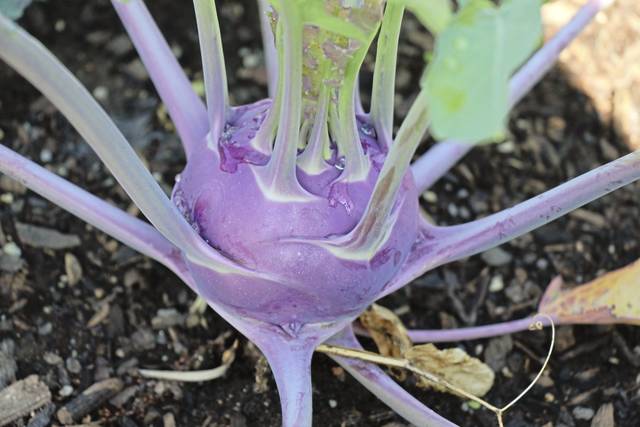Why kohlrabi split and how to grow them
Question: I grew kohlrabi in my garden this year. Most of them split. What causes them to split and are they still safe to eat?
Answer: For those not familiar with this delicious and crunchy vegetable, let me sing the praises of the kohlrabi before I dive into what likely happened to your crop.
Once a popular vegetable due to its long storage life, kohlrabi is a member of the cabbage family. Though sometimes people call it a kohlrabi “bulb,” the edible portion of the plant isn’t actually a bulb; it’s a swollen, above-ground stem.
Eaten both raw and cooked, kohlrabi has a mild, slightly sweet, cabbage-like flavor. It’s nutritious and filled with fiber. You can grate it into a slaw, bread and fry it (much like you would do when making eggplant Parmesan), or cook and puree it to make a smooth soup.
Like other members of the cabbage family, kohlrabi is a cool-season vegetable. Seeds should be started very early, indoors under grow lights. The seedlings can be moved out into the garden in early to mid-April. Waiting too late in the season to plant your kohlrabi crop could result in poor “bulb” formation, a slightly bitter flavor and possibly cracking.
Kohlrabi can also be grown in the autumn for winter harvests. To do this, sow seeds directly into the garden in late July or early August. Since it takes around two months for them to reach maturity, late-season plantings will be ready to harvest soon after they’ve been sweetened by fall’s first frosts.
Like other cole crops, kohlrabi is tolerant of frosts and cold weather. Fall-planted crops can be protected with a cold frame or a few layers of floating row cover. This continues harvests into early winter.
Kohlrabi come in both green and purple varieties.
The splitting is likely caused by one of several issues. First, as mentioned above, if you plant them too late in the spring, hot weather can cause them to crack.
Second, during seasons where we get a lot of rain, the “bulbs” sometimes split. This is because the excess water they absorb collects in the tissue and causes it to swell to the point of cracking. This can also happen when prolonged periods of wet are followed by prolonged periods of dry.
And third, the splitting could be due to a delayed harvest. Kohlrabi should be pulled when they’re about the size of a tennis ball. If they’re left in the garden too long, they can split open. It’s better to harvest them as soon as they reach the best size, remove all the leaves, and store the harvested “bulbs” in a plastic bag in the fridge or in a cold cellar. If stored properly, they’ll last for months.
Split kohlrabi are perfectly fine to eat. Simply cut away any callus tissue that forms around the cut. Do not eat them, however, if they’ve developed rot. Split kohlrabi should be eaten quickly as they will not store well.
Horticulturist Jessica Walliser is the author of several gardening books, including "Attracting Beneficial Bugs to Your Garden," "Good Bug, Bad Bug," and her newest title, "Container Gardening Complete." Her website is jessicawalliser.com. Send your gardening or landscaping questions to tribliving@tribweb.com or The Good Earth, 622 Cabin Hill Drive, Greensburg, PA 15601.
Remove the ads from your TribLIVE reading experience but still support the journalists who create the content with TribLIVE Ad-Free.

